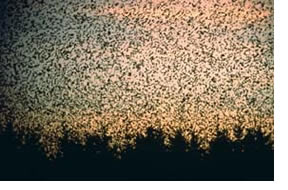




 |
| Computers reveal how birds flock How flocks of birds can bank and wheel as one, but never collide.
Do birds fly in such synchronicity from instinct, brain chemistry or divine intervention? No one knew for sure until 1986, when computer scientist Craig Reynolds synthesized flocking behavior on a computer screen. Creating paper airplane icons called "boids," he gave them three rules:
The last directive makes sense because to conserve energy, predators choose prey from the outside of a flock. Since birds at the flock's edges face greater danger than those in the center, they constantly press inward and push those inside out. When Reynolds freed his computer birds, they started out scattered randomly over the screen, but they soon collected into swooping, wheeling flocks that flowed around obstacles. With no leader or imperative to flock, they became one by obeying individual rules. And perhaps those rules could be applied to traffic. If each driver kept up with other drivers, didn't stray too far from the rest and tried to avoid bumping into other cars, we might drive to work each day in gentle, spontaneous flocks, rather than long lanes of road-rage crazed individuals.
|



